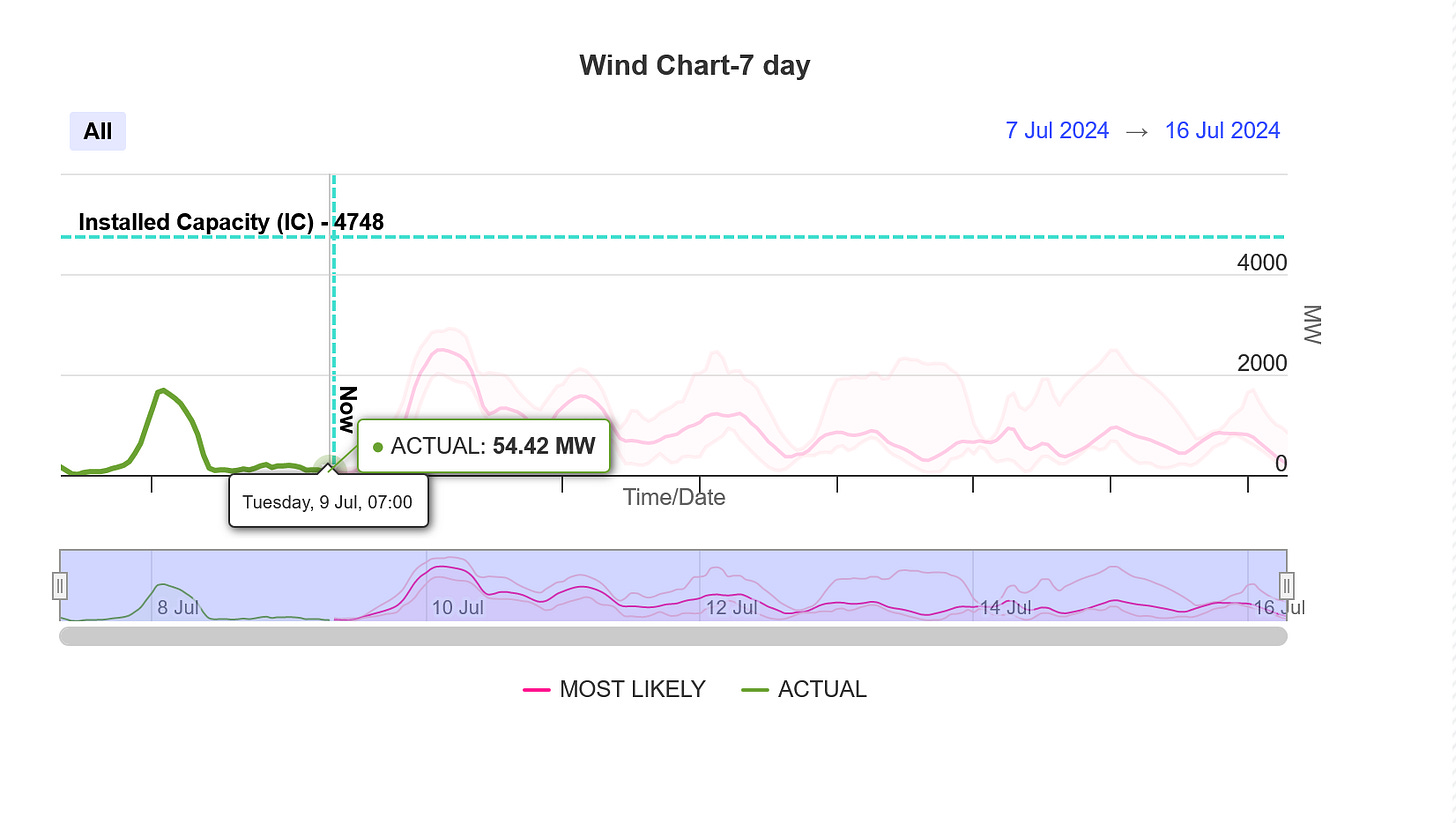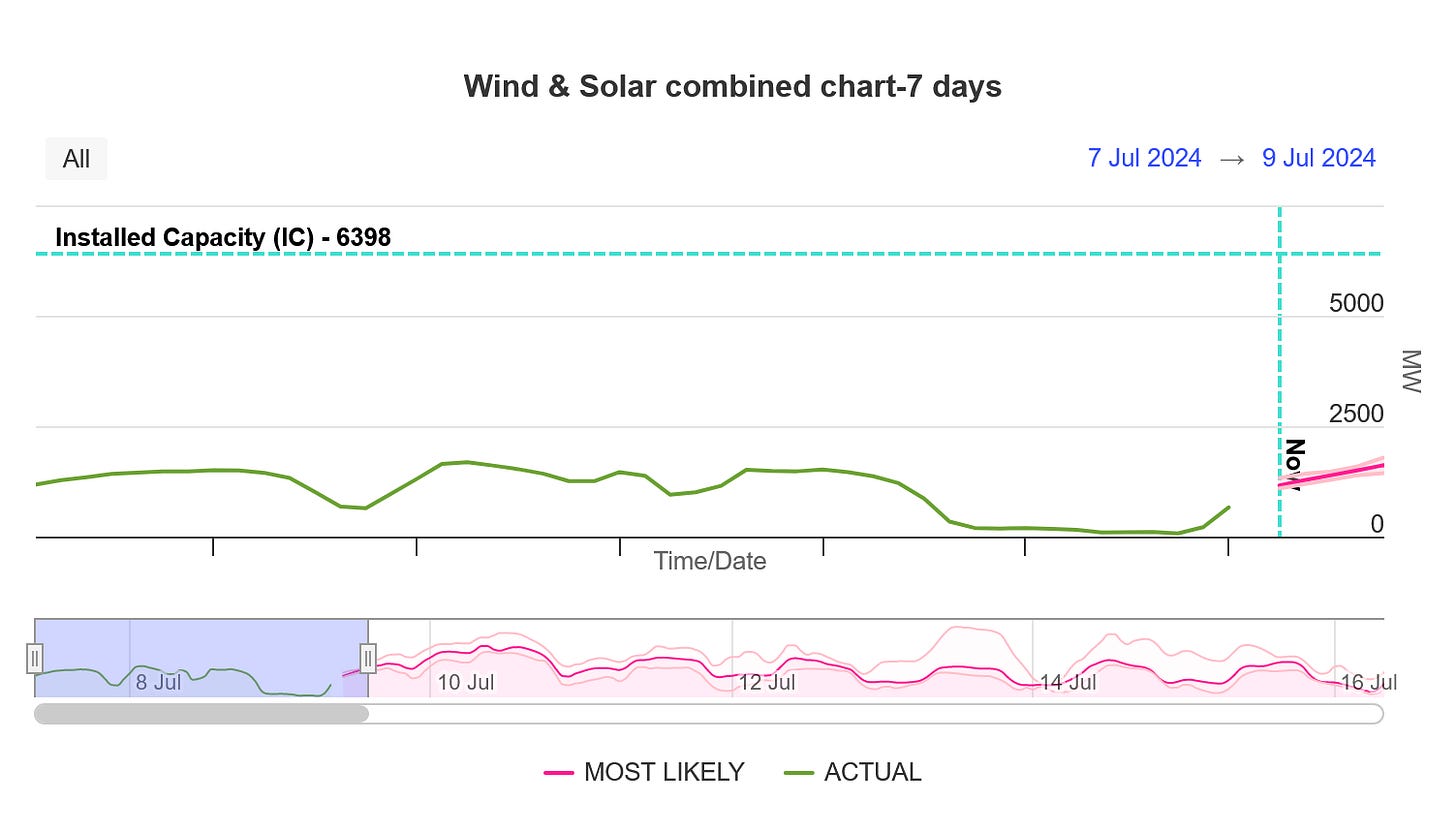Here We Go Again….
Alberta's wind and solar output plunge to near zero...again.
“Insanity is doing the same thing over and over and expecting different results" - Attributed to Albert Einstein.
During the evening of July 8th, 2024, Alberta’s grid operator (AESO) once again issued a Grid alert, requesting that consumers reduce power consumption to avoid a potential grid brownout or blackout as wind output dropped to near zero and the sun started to go down, resulting in solar dropping off of the map.
As long time readers know, we’ve covered multiple grid alerts in Alberta, where the grid strained to keep up with demand, or as in the case in April of 2024, the grid couldn’t generate enough power leading to brownouts.
To be fair, all systems can break. Yes, a natural gas power plant can breakdown, and a reliable grid needs a comfortable operating margin so that if any one or two plants go down, the system can handle the loss without impacting consumers. And as
has pointed out, if you rely too much on just-in-time pipeline delivery for natural gas, what happens if the pipelines go down?However, wind and solar are uniquely vulnerable to “breaking down.” One obvious reason is that wind and solar are weather dependent and weather is fickle, and it can change on a dime. But it is a much more nuanced, multi-faceted problem, making simple solutions like ‘just add batteries’…well… “ clear, simple, and wrong.”
These problems include:
The intermittency of weather: the sun sets and the wind doesn’t always blow. Unfortunately, we hear that wind and solar are the cheapest sources of power. If you look at the Levelized Costs Of Energy models behind those claims, they tend to use a simple average output, assuming wind and solar have a perfectly steady, 24/7/365 output for 20 or 30 years. It makes it easy to math, but there’s nothing realistic about those assumptions. In Cheap, If you Ignore $3 Trillion, we break down some of the silly assumptions behind the claim that wind power is cheap.
The variability of that weather, It would be ‘easier’ if wind moved up and down consistently and fairly steadily like an ocean tide. Instead, wind is like a fly stuck in a car looking for a way out. It buzzes all over the place in seemingly erratic and quickly changing pathways. This makes it very difficult to constantly start-stop the rest of the grid to keep up with the fickle renewables.
The difficulty in precises predictions: In Injecting Chaos, we discussed how wind acts as a lever on wind turbine output. Small changes in wind speed can have massive, disproportionate impacts on wind output, especially at medium to lower wind speeds. This makes it very hard to plan a grid around wind since it’s extremely difficult to precisely predict exactly how fast the wind will blow, where it will blow, and how much it will change in a given period.
Seasonality: One of the biggest problems with renewables is that they tend to be seasonal. While this should be a detailed topic of a future article, there’s no battery on earth capable of storing enough solar in summer to cover for its low output in winter, at least not to any scale. It’s a similar story with wind, which tends to peak in the spring and fall.
System-wide risks: Weather patterns can impact a large region of the continent at the same time. Yes, in theory we can just string up more transmission lines. But if those transmission lines only connect wind farms that don’t have wind, they’re useless at solving the systematic risk problems. This can magnify renewable grid failures.
Integration Risks: This is a very broad topic. This includes the trouble with handling the floods of excess power when it’s windy and sunny. And it also covers the risks and challenges of solving grid frequency and inertia problems. Here’s a nice post by the
on the challenges of renewables and inverters.Backup Risks: when the wind isn’t blowing and the sun isn’t shining, someone has to generate the power, meaning we need a 2nd grid standing by. Who wants to pay for 2 grids at the same time? Yet that’s exactly what happens. The risk with the 2 grids is that subsidized renewables can push out reliable power generators, leaving the 2nd grid just a little bit short on enough generators to cover a stressful event, leading to potential blackouts. As we demonstrated in Germany’s Rube Goldberg Machine, Germany’s renewables based grid still has nearly as many fossil fuel plants as it did 2 decades ago, and Germany still needs them when wind and solar all but disappear.
Opportunity costs: we could add a lot of reliable power generation to give us a very comfortable margin for pretty much any grid event. Instead, we’re pouring billions into the least reliable, most prone-to-fail systems. The price of that is giving up the opportunity for reliability.
With that risk review in mind, let’s travel over to Alberta to see what’s going on. Put simply, wind and solar failed as the mid-continent experienced relatively low wind speeds. Fortunately for Alberta, they had enough fossil fueled power to kick in to avoid a grid brownout and the Grid Alert was soon canceled.
But wind was still AWOL. Wind output crashed Monday morning down to around 1.9% of it’s capacity (89.56MW) just before lunch time. Here’s a snapshot from AESO, Alberta’s grid operator.
And wind output bounced along the ground near zero for the next 20 hours. Here’s what Alberta’s wind output looked like Tuesday morning, at barely 1% of it’s capacity. Yes, to be fair, wind was able to stage a rally and reached 5% output (compared to installed capacity) in the middle of the night, but that micro-rally soon faded.
Even with wind and solar combined, renewables output dropped to near zero and remained there for around 11 hours during the night of July 8 to the morning of July 9.
In fact, around 0723am local time on Tuesday July 9, natural gas, hydro, dual fuel and other power plants provided 99% of Alberta’s power, while wind, solar, and batteries combined generated about 1% to total grid demand. At that time, combined wind, solar, and batteries were generating at 1.23% of capacity.
Folks, you can’t make this up. This is just another example of a massive failure of renewables. When renewables only make up a small part of the grid, it’s not a big deal. But the more renewables in the grid, the bigger the hole they rip in the grid when they disappear.
Yet Alberta isn’t alone over the past few days. Fortunately, this wind ‘drought’ is occurring when temperatures in the Midwest are relatively mild compared to what they were last week.
But in much of the central part of the continent wind output is also struggling. Here’s wind producing at around 5.5% of its capacity on Tuesday morning in the Texas ERCOT Grid:
And for the Southwest Power Pool, that covers parts of the central continental USA from Texas up to Canada, it’s a similar story.
While renewables are contributing to the grid, its output is a fraction of its capacity. And as the sun rises Tuesday, solar output will increase. Don’t be surprised if this failure of renewables gets spun into ‘ renewable output rises to save the grid.’ Well, when you start at zero or near zero, there’s really only one place to go!
We’ll close by quoting the
and in a piece entitled 3 Energy Realities That Renewable Advocates Can’t Answer:“As more wind and solar generators are placed on a grid, it becomes more vulnerable to rolling blackouts because states or regions tend to neglect the importance of the dispatchable generators in their fleet to focus on wind and solar. These areas also tend to retire coal or nuclear plants in favor of less-dependable natural gas.”
Our grid operators, legislators, and political leaders would be wise to heed their warning.
As always, thanks for reading!








Very well written and engaging article.
Reminds me of the deep freeze in TX that seized all the turbines solid. These had to de-ice by spraying fluid from helicopters!
As always great read. And Tuco's Child is spot on Albert is experiencing what The Great State of Texas experiences. Wind energy performed poorly during the winter storm starting with ice accumulation that led to some wind farms needing to shut down early in the crisis. Wind power outages peaked at about 9 gigawatts, a number that takes into account wind levels on those days and while large amount of power that was lost was natural gas 25 gigawatts ,coal and nuclear outages cut another 4.5 gigawatts and 1.3 gigawatts respectively, of the 40 something gigawatts that was on the grid, it was natural gas, coal, & nuclear, wind so zero! The reason for the large drop in number for natural gas is do to the fact that it's makes up the majority of the grid. So as more and more weather depend source come online we should expect this to occur and if we can short it, boy we could make a killin!